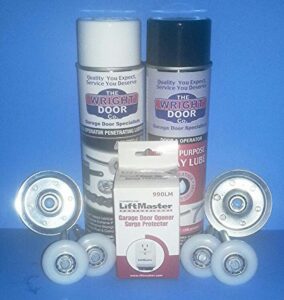Regular Lubrication is Necessary
Regular lubrication is necessary for maintaining your garage door’s performance and preventing costly repairs. Neglecting simple maintenance can lead to increased noise, wear, and potential malfunctions. This simple guide will walk you through properly lubricating your garage door for optimal results.
What You Need for the Job

Not all lubricants are created equally, and the one you choose can significantly affect your garage door’s performance. Silicone-based lubricants are a standout option. They offer lasting lubrication, resist attracting dirt, and maintain their consistency in both scorching summers and freezing winters, making them perfect for hinges, rollers, and springs. Opting for a silicone-based lubricant or a 3-n-1 oil will keep everything running smoothly and ensure your garage
door parts get the protection they need. Whenever possible, choose spray lubricants for their user-friendly application. They allow you to direct lubrication into tight spaces with precision, which is especially handy for garage door springs. You can thoroughly coat them without ever having to touch or manipulate the springs, making the process both effective and safe.
Pre-Lubrication Inspection
When you begin, it’s important to inspect your garage door for any issues that may need attention:
- Inspect for Excessive Wear: Look for heavy wear or damage on rollers and hinges. Replace any badly worn parts before proceeding to lubrication.
- Tighten Loose Hardware: Secure any loose screws, nuts, or bolts to prevent unnecessary vibration and wear.
By following this quick inspection, you’ll address any underlying issues and help your garage door function at its best—right in time for lubrication!
Parts to NOT Lubricate
Dirt, dust, and debris can interfere with your garage door’s performance. Follow these steps to clean effectively:
- Never Lubricate Tracks – You can Wipe the Tracks: Use a clean cloth to wipe down the tracks, removing dust and debris. Do not lubricate the tracks; they should remain dry for proper alignment and function. Lubricating the tracks can cause rollers to slip and hinder the door’s movement.
Why Skip Lubricating the Tracks? It might seem logical to apply lubrication for reduced friction, but it has the opposite effect. Over time, lubricants can build up and form sticky residue, excessive noise, jerking motions. The best practice? Clean the tracks thoroughly and leave them dry.
- Avoid Bottom Seal and Weatherstripping: Do not apply lubricant to these areas, as it can cause materials to degrade over time.
- Avoid Nylon Parts: Avoid lubricating nylon rollers or other nylon components, as a lubricant can weaken the material and dilute grease if it has a sealed bearing.
- Protect Powder-Coated Finishes: Refrain from applying lubricant to any powder-coated finishes, as it can damage the coating.
Be mindful of the photo sensors at the bottom of your garage door. If you accidentally move one of them, the invisible beam will be obstructed, and the garage door won’t close.
Inspect for Wear and Signs of Needed Lubrication
Regular inspection is crucial for identifying when your garage door might need more frequent lubrication. Look for these signs:
- Increased Noise: If your garage door becomes louder during operation, it could indicate that moving parts are dry and require lubrication.
- Slower Movement: A door that moves slower than usual or hesitates during operation may need lubrication to reduce friction and improve performance.
- Jerky Performance: Uneven or jerky movement is often a sign of inadequate lubrication on rollers or hinges.
- Visible Wear or Corrosion: Check for signs of rust or wear on springs, rollers, and other moving parts. These issues can worsen without regular lubrication. An indication can be black dust on the moving parts.
Environmental factors, such as extreme cold or high humidity, can increase the need for lubrication. High-usage doors, such as those in commercial settings, also experience more wear and require frequent maintenance.
Regular inspection helps ensure your garage door operates efficiently and avoids costly repairs.
Apply Lubricant to Key Components
Use a silicone-based or 3-n-1 oil lubricant and apply it sparingly to the following parts:
- Hinges: Pay special attention to the pivot points where the door bends. By lubricating these areas, you’ll help the door sections move more smoothly. Start by wiping away any dirt or debris so the lubricant can properly adhere.
- Rollers: Focus on the ball bearings within each roller, ensuring you lubricate only the metal components—especially important if you have steel rollers. Avoid spraying lubricant directly on the nylon, as it can break down the material. Start by wiping off any dirt or buildup so the lubricant can properly adhere.
- Springs and Bearing Plates: (only with spray lubricant to avoid handling them) Lightly coat the torsion or extension springs to reduce friction and prevent rust. The bearing plates, which are the circular moving components on either side of the springs, also require proper lubrication.
Safety Note: Garage door springs are under high tension. If you notice damage, contact a professional rather than attempting repairs yourself. Work in the spring area with caution!
- Chain or Screw Drives: If your opener uses a chain or screw drive, apply lubricant sparingly to reduce noise and ensure smooth operation. On a screw drive opener use a Low-Temp grease.

- Belt Drives: For belt-driven openers, apply a small amount of lubricant to the drive rails or as specified by the manufacturer. Avoid over-lubricating to prevent slippage.
- Opener Arm: Lightly lubricate the connection point between the opener arm and the garage door to ensure smooth operation.

If you have any questions or comments on how we can help keep your Garage Door secure please give The Wright Door Co. a call 314-484-3667, 636-293-3007 or 618-698-8058. Delivering Quality You Expect, Service You Deserve is our Goal.